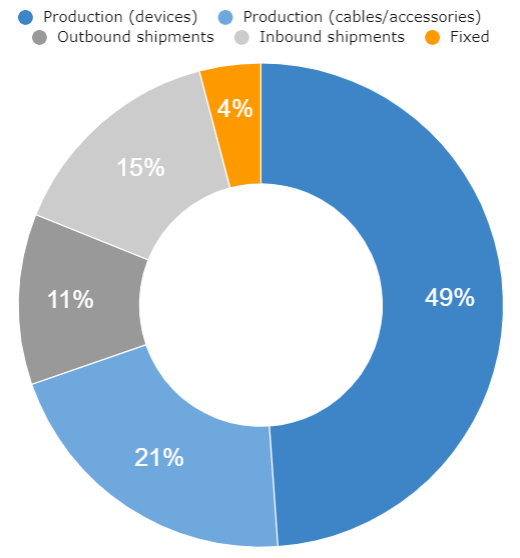100% CO2 Neutral - Since 2015
At CSS Electronics we care about the environment.
We take action in two ways:
1# Minimize our footprint
Our first priority is to minimize our existing footprint via various initiatives:
- Minimal business travel (zero flights since 2015)
- Minimal travel by car across all employees
- Encouragement of our suppliers to carbon neutralize
- Discounts for projects with clear environmental focus (contact us)
2# CO2 neutralize the rest
The footprint that we're currently unable to eliminate, we offset instead:
- We offset 100% of our 'fixed' footprint (office, travel, equipment, waste, ...)
- We offset 100% of our outbound shipments
- We offset 100% of our inbound shipments
- We offset 100% of our production/parts
We neutralize the above annually via atmosfair at 23 EUR/tonne.
This CO2 neutralization has been done for all our years in operation (i.e. since 2015).

Our 2023 CO2 usage by category
Our calculations
If you're interested in implementing a similar approach - or have any suggestions - please contact us.
We have not yet found a clear, simple standard method for deciding what categories should be included in a company's footprint. We therefore took outset in what we think is logical - leading us to below categories:
Fixed: This includes office heating, energy, mobility (employee journeys to work), food, material and waste.
How? We use the calculator from myclimate.org (applying standard rates for most categories excl. mobility).
Outbound shipments: We ship our products across 100+ countries, which generates a significant share of our footprint.
How? We asked FedEx to provide a PDF report of our CO2 usage across all outbound shipments.
Inbound shipments: We include direct inbound shipments in our footprint - i.e. shipments of e.g. partial products, cables etc that go directly to us. Note that we do not include the shipments that our suppliers receive.
How? For simplicity, we assume what goes out also goes in - so we set this equal to our outbound shipment usage.
Production: This category is comprised by the products, including components, PCBs, cables, assembly etc.
How? This is difficult to estimate, despite extensive research. We've found very few resources with CO2 rates for PCBs or similar electronics devices. We currently use a rate per device inspired by tables from 'Materials and the Environment: Eco-informed Material Choice'. Further, we've triangulated using e.g. CO2 estimates for the production of smart phones and other electronics. We'd be interested in alternative sources that are specific to the footprint of e.g. PCBs. The current rate we use is 4 KG CO2 per device (CANedge, CANmod, CLX000) and 2 KG per cable/accessory.
Based on our crude research, the CO2 offset rates range from 0.1 EUR to 30 EUR across most compensation schemes. We've found that the most popular offsetting pages use rates between 10 EUR and 25 EUR.
We decided to go with 23 EUR/CO2 tonne, as we found this to be in the mid/high-end across the offset providers. It also happens to be the recommended rate by atmosfair, who we use for offsets. Given the uncertainty involved in some of our estimates, we wanted to avoid using a low-end rate.
We reviewed various offset providers and ended with atmosfair. We did some research and found that they were generally seen as a company with high integrity and extensive certification. Further, we feel their principles and values are in sync with our own. Other popular alternatives include the Carbon Fund, Fair Climate Fund and Trees for all.
The climate challenge needs to be solved now, not in 2050. We hope to play a small role in inspiring others to get started now.